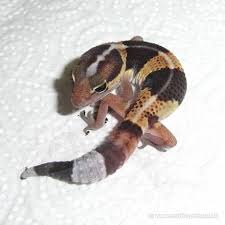REGULAR/STRIPED FAT TAILED GECKO (Hemitheconyx caudicinctus)
$130.00
Full Description
Here is a detailed care guide for the Regular / Striped African Fat-Tailed Gecko (Hemitheconyx caudicinctus), which includes both the wild-type (regular banded) and the striped morph. Both are very similar in husbandry needs and make excellent reptile companions, especially for beginners.
Regular / Striped African Fat-Tailed Gecko Care Guide
Morph Overview
| Trait | Description |
|---|---|
| Common Names | African Fat-Tailed Gecko, Striped Fat-Tailed Gecko |
| Scientific Name | Hemitheconyx caudicinctus |
| Morph Types | Regular (banded), Striped (recessive morph) |
| Experience Level | Beginner-friendly |
Size & Lifespan
| Feature | Typical Range |
|---|---|
| Adult Size | 7–9 inches (18–23 cm) |
| Adult Weight | 45–75 grams |
| Lifespan | 15–20+ years in captivity |
Enclosure Setup
Enclosure Size
| Gecko Age | Minimum Tank Size |
|---|---|
| Hatchling | 10–15 gallons |
| Adult | 20-gallon long tank |
✅ Horizontal space is more important than vertical.
Substrate Options
| ✅ Safe | ❌ Unsafe |
|---|---|
| Paper towels | Loose sand |
| Reptile carpet | Wood chips or bark |
| Ceramic or slate tile | Soil with perlite or gravel |
| Bioactive (for advanced keepers) | Calcium sand or dusty substrates |
️ Temperature & Humidity
| Zone | Temp (°F) | Temp (°C) |
|---|---|---|
| Warm Side | 88–92°F | 31–33°C |
| Cool Side | 75–80°F | 24–27°C |
| Nighttime | 70–75°F | 21–24°C |
| Humidity | 50–70% | Maintain with humid hide |
Use an under-tank heater (UTH) with thermostat
Provide a humid hide using moist moss or paper towel
Monitor with digital thermometer and hygrometer
Lighting
-
UVB lighting is optional, but 2–5% UVB is beneficial
-
Provide a 12-hour light/dark cycle
-
Avoid harsh or bright lights—these are crepuscular/nocturnal animals
️ Hides & Decor
| Type | Purpose |
|---|---|
| Warm Hide | Thermoregulation |
| Cool Hide | Rest and comfort |
| Humid Hide | Aids in hydration and shedding |
| Extras | Cork bark, rocks, fake plants |
Ensure all décor is secure and cannot fall over.
Diet & Feeding
Insect Options
| Feeder Insect | Notes |
|---|---|
| Crickets | Stimulates natural hunting |
| Dubia roaches | High protein, excellent staple |
| Mealworms | Easy to dish feed |
| Black soldier fly larvae (BSFL) | High calcium |
| Waxworms/superworms | Treat only (high fat) |
Feeding Frequency
| Gecko Age | Feeding Schedule |
|---|---|
| Juveniles | Daily |
| Adults | Every 2–3 days |
Supplements
| Supplement Type | Frequency |
|---|---|
| Calcium (no D3) | Always available |
| Calcium + D3 | 1–2× per week |
| Multivitamin | 1× per week |
✅ Always gut-load insects 24–48 hrs before feeding.
Cleaning & Maintenance
| Task | Frequency |
|---|---|
| Spot cleaning waste | Daily |
| Replace water | Daily |
| Refresh humid hide | 1–2× per week |
| Deep clean tank | Monthly |
Morph-Specific Notes
| Morph | Details |
|---|---|
| Regular (Banded) | Typical wild-type pattern with dark and light horizontal body bands |
| Striped | A recessive morph showing a clear dorsal stripe from head to tail; pattern may fade with age |
| Color | Browns, tans, and creams; some variation among individuals |
| Temperament | Calm, curious, and relatively slow-moving |
Handling Tips
-
Let new geckos settle in for 1–2 weeks before handling
-
Keep initial sessions short (5–10 minutes)
-
Avoid handling during shedding or right after feeding
-
Always support the full body; do not grab by the tail
✅ Quick Care Recap
| Feature | Summary |
|---|---|
| Enclosure | 20-gallon long (adult) |
| Substrate | Paper towel, tile, or bioactive |
| Heating | 88–92°F on warm side |
| Humidity | 50–70%, plus a moist hide |
| Lighting | UVB optional (2–5%) |
| Diet | Insects with supplements |
| Temperament | Calm, docile, beginner-friendly |

